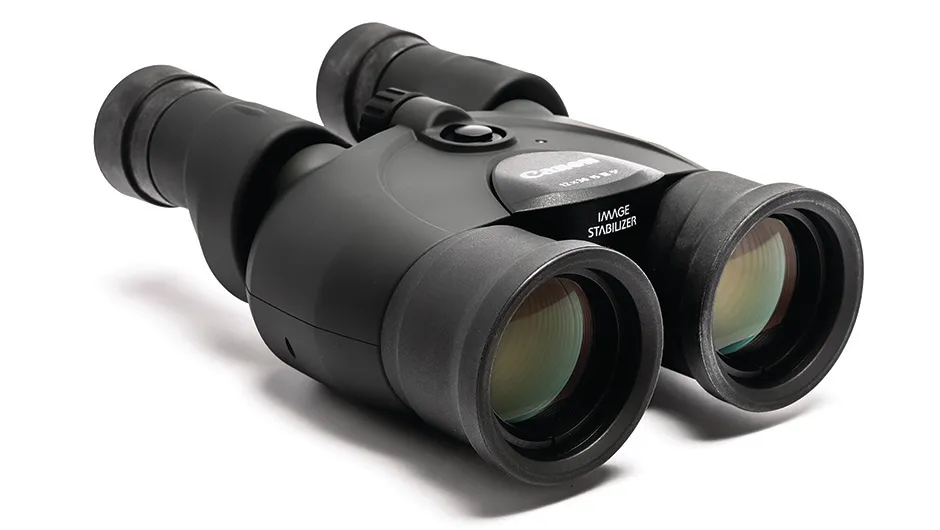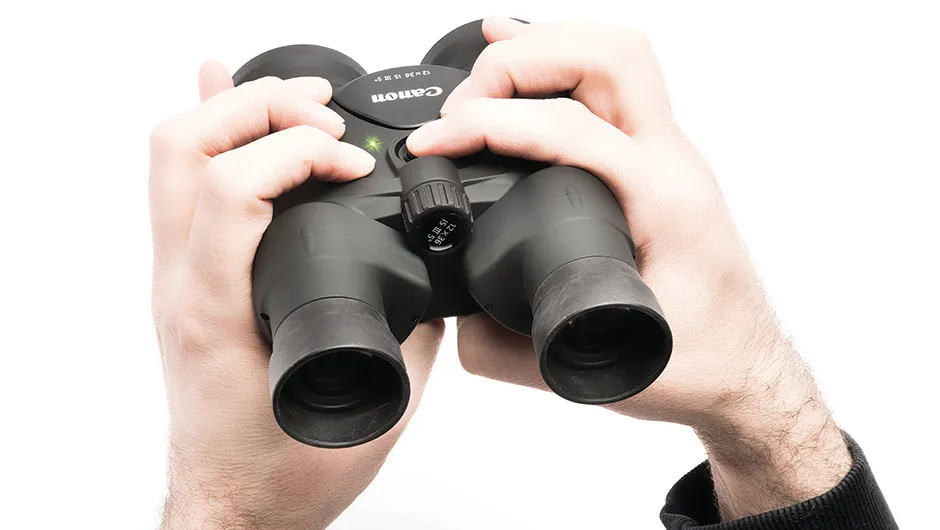The technology of image stabilisation is undergoing continual improvement so we hoped for great things from the latest incarnation of Canon’s 12x36 IS binoculars – and we weren’t disappointed.
The binoculars come in a soft, slightly padded fabric case and include a wide neckstrap that we found to be very comfortable over a jacket collar.
There are individual eyepiece caps that fit very well, but no caps for the objective lenses.
No instruction manual is included, but the binoculars are intuitive to use and, if you decide you want a manual you can download one from Canon’s website.

The binoculars are covered with matt rubber armour which gives a secure grip and offers some protection in normal use.
The prism system is a Porro Type II, which means that you adjust the interpupillary distance by rotating the entire eyepiece assemblies.
They move smoothly, with enough resistance to ensure that they will not accidentally slip once they have been set.
The same applies to the right eyepiece dioptre adjustment, which has a range of ±3 dioptres. Centre focus is light and smooth.
The binoculars are neither waterproof nor nitrogen filled.
The eyecups fold down to below the surface of the eyepieces, so the full 14.5mm eye relief is available, but we found that this was inadequate for some spectacle wearers, who were unable to see the full field of view.
The focal range of the binoculars extends several dioptres ‘beyond’ infinity, so most people with focus defects of their vision should be able to observe without their glasses.
The narrow eyepiece barrels make it very easy to find the optimal position for your eyes.
Champion coatings
When you hold the binoculars up to the light, the exit pupils appear perfectly round, with no cut-offs or grey segments, indicating that the prisms are fully sized and that the glass used has an appropriate refractive index.
Canon has not specified the extent of its proprietary ‘Super-Spectra’ multicoatings, but when we shone a light down the objective end there was minimal light reflected from its surface, while the bright white light reflected from an internal component suggested that not all glass-air optical surfaces are coated.
When we observed the Moon and Jupiter (or held them just outside the field of view) there were no spurious ghost images, so the coatings are certainly fit for purpose.
The control of stray light is excellent.
Chromatic aberration was minimal, although visible on bright objects when off-axis.
When we focused on the Pleiades open cluster in Taurus the image was flat and crisp almost to the edge, a testament to the efficacy of the field-flattener lens in the optical train.
We then pressed the button to engage the image stabilisation and, not only did the image become stock-still, but fainter stars became visible.
We did not quantify this, but estimate that the binoculars give approximately another 0.25 magnitudes of depth without the need for any bulky mounting system.
With an aperture of 36mm, the laws of optics limit the usefulness of these binoculars when it comes to faint deep-sky objects, but the image stabilisation certainly helped to extract structural detail from the Orion Nebula.
But the most severe test we gave the binoculars was observing Jupiter’s Galilean moons when Callisto and Europa were each only 40 arcseconds from Ganymede.
When the seeing became steady, not only was it obvious that there were three moons but, on the other side of Jupiter, a mere 37 arcseconds from Jupiter’s disc, Io was also fleetingly visible despite the brightness of the planet.
The Canon 12x36 IS III binoculars would be best suited to observers who already use a telescope or larger binoculars as their main instrument, but also want a single multi-purpose instrument.
Certainly these binoculars could easily be used for terrestrial purposes as astronomical ones.
These binoculars appear on our list of the best binoculars for astronomy and stargazing

Excellent image stabilisation
Canon has continuously improved its Vari-Angle Prism image stabilisation system since it was introduced in 1990s.
Earlier implementations took several seconds to stabilise the image and even then the resulting view was frequently afflicted with a ‘swimming’ sensation and reduced sharpness.
The new generation of motion sensors obviously respond exceptionally quickly to any motion or vibration and, as a consequence, the image settles down quickly and is remarkably steady.
In the Canon 12x36 IS III, the image stabilises within one second and we were unable to get it to ‘swim’ even when we tried to induce this by deliberately vibrating the binoculars.
Nor were we able to detect any reduced sharpness.
The somewhat surreal result of trying to fool the image stabilisation system was a perfectly steady view surrounded by shaking binoculars.
The Vari-Angle Prisms can correct for up to 0.8° deflection, so the image stabilisation system can deal with unsteadiness of a greater amplitude than most people have.
Canon 12x36 IS III binoculars: 5 best features
Super Spectra multicoatings
These binoculars feature the same Super Spectra anti-reflective coatings as its EF range of camera lenses. They reflect only a minimal amount of light and transmit the full visible spectrum, resulting in images with a faithful colour rendition and very good contrast.
Porro Type II prisms
The binoculars use the compact Porro Type II prism system. This cemented system has several advantages over the more common Porro Type I prisms: as well as allowing a greater interpupillary distance range, it offers increased light transmission and fewer surfaces where chromatic dispersion, light scatter and spurious reflections can occur.
Objective lens focusing
The focusing mechanism works by moving the objective lenses inside the binocular body. This has the advantage of eliminating the eyepiece bridge, which makes it easier to seal the binoculars against dust and also has the advantage that any pressure on the eyepieces will result in defocusing.
Batteries
Image stabilisation is powered by two AA batteries, with a specified life of nine hours at 25°C, falling to one hour at –10°C. These batteries are readily available, so you would be very unlikely to be caught out in a situation where they have run out of power and you could not source a replacement.
Good interpupillary distance range
With an interpupillary distance of 55-75mm, these binoculars offer great flexibility. The narrow eyepiece barrels mean that there is 17mm between the soft rubber eyecups at the minimum interpupillary distance, so they should comfortably fit even the smallest of faces.
Vital stats
- Price: £659.99
- Weight: 660g
- Supplier: Canon
- Telephone: 01737 220000
- Website:www.canon.co.uk
This review originally appeared in the June 2016 issue of BBC Sky at Night Magazine.
